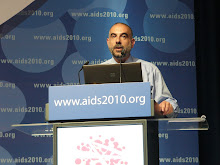Visit my blog: Criminal HIV Transmission
about me

- Edwin J Bernard
- Berlin, Germany, and Brighton, United Kingdom
- An advocate for the rights of people living with HIV, I work as a freelance writer/consultant on HIV-related issues. As a consultant, I work with: The Joint United Nations Programme on HIV/AIDS (UNAIDS); The Global Network of People living with HIV (GNP+); NAM (National AIDS Manual); and NAT (National AIDS Trust). As a journalist, I write for aidsmap.com and POZ magazine. For further information about me, and my work, please visit my website.
HIV Forensics (from Criminal HIV Transmission; NAM, 2007)
February 16, 2008
This is a short excerpt – a summary at the start of the HIV Forensics chapter – from my book, Criminal HIV Transmission, published by NAM in April 2007.
To purchase the book, please visit NAM's bookshop.
• When investigating an alleged criminal HIV transmission case, individual elements of the scientific evidence should be seen as small pieces of a much larger puzzle.
• Even the rarest HIV subtypes and recombinants have been found in more than two people in the UK (and some subtypes and recombinants have been found in hundreds, if not thousands of people in the UK).
• Sharing the same HIV subtype or recombinant does not ‘prove’ that transmission occurred between the complainant and defendant.
• Phylogenetic analysis can only estimate how closely related two samples of HIV are likely to be: it is a grey area – unable to create a definitive ‘match’.
• HIV, unlike human DNA samples or fingerprints, is never unique to an individual.
• Consequently, although two individuals may have HIV strains that appear to be closely related, this will not necessarily be unique to the two individuals but could extend to other people who are part of the same transmission network.
• Even with the appropriate comparison samples, phylogenetic analysis cannot ‘prove’ that HIV transmission occurred directly between two individuals
• If phylogenetic analysis is carried out rigorously it is reliable enough to show that the virus from the person under investigation and the complainant are not closely related to each other. In other words, it can exonerate (eliminate, in an investigators words) the suspect.
• Even if phylogenetic analysis suggests that the two viruses are highly similar, this does not provide enough information to know the direction or timing of the alleged transmission (i.e. who might have infected who; or who might have been infected first).
• Medical records can be accessed by the police and used in a court of law if they are relevant to a case, by obtaining a search warrant or court order.
• Neither the person under investigation nor the complainant may have been totally honest when relating their sexual history to a clinician, consequently medical notes may not be totally reliable in providing information about sexual risks.
• However, medical records will contain accurate information on clinical symptoms, as well as virological and immunological information.
• Establishing when both the person being investigated and the complainant were infected (rather than diagnosed) with HIV is important, but not always possible.
• Attempting to work out the timing of HIV infection via physical symptoms, immune status or by levels of HIV in the blood is extremely difficult, and should always be interpreted with great caution.
Labels: Criminal HIV Transmission, HIV forensics